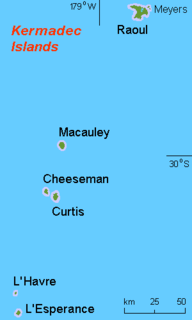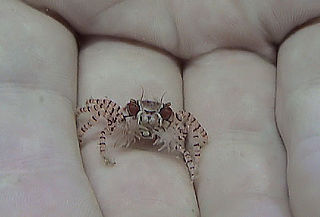
The Kermadec Islands are a subtropical island arc in the South Pacific Ocean 800–1,000 km (500–620 mi) northeast of New Zealand's North Island, and a similar distance southwest of Tonga. The islands are part of New Zealand, 33.6 km2 (13.0 sq mi) in total area and uninhabited, except for the permanently manned Raoul Island Station, the northernmost outpost of New Zealand.

Heteractis magnifica, also known by the common names magnificent sea anemone or Ritteri anemone, is a species of sea anemone belonging to the Stichodactylidae family native to the Indo-Pacific area.

Urticina crassicornis, commonly known as the mottled anemone, the painted anemone or the Christmas anemone, is a large and common intertidal and subtidal sea anemone. Its habitat includes a large portion of the coastal areas of the northern hemisphere, mainly polar regions, and it lives a solitary life for up to 80 years. Mottled anemones are similar to Dahlia anemones and both are commonly referred to as northern red anemones.

Members of the genus Metridium, also known as plumose anemones, are sea anemones found mostly in the cooler waters of the northern Pacific and Atlantic oceans. They are characterized by their numerous threadlike tentacles extending from atop a smooth cylindrical column, and can vary from a few centimeters in height up to one meter or more. In larger specimens, the oral disk becomes densely curved and frilly.

Sea anemones are the marine, predatory animals of the order Actiniaria. They are named after the anemone, a terrestrial flowering plant, because of the colourful appearance of many. Sea anemones are classified in the phylum Cnidaria, class Anthozoa, subclass Hexacorallia. As cnidarians, sea anemones are related to corals, jellyfish, tube-dwelling anemones, and Hydra. Unlike jellyfish, sea anemones do not have a medusa stage in their life cycle.

Sagartia troglodytes is a species of sea anemone in the family Sagartiidae, also known as the mud sagartia or the cave-dwelling anemone.

Metridium senile, or frilled anemone, is a species of sea anemone in the family Metridiidae. As a member of the genus Metridium, it is a type of plumose anemone and is found in the seas off north-western Europe and both the east and west coasts of North America.

Metridium farcimen is a species of sea anemone in the family Metridiidae. It is commonly known as the giant plumose anemone or white-plumed anemone. It is found in the eastern Pacific Ocean from Alaska down to Catalina Island, California.

Triactis is a genus of sea anemone in the family Aliciidae. It is monotypic, having only one species – Triactis producta. This is found in shallow waters in the Indo-Pacific where it lives on the seabed, rocks and corals. It derives much of its energy needs from the symbiotic algae it contains. It also forms a mutualistic relationship with small Lybia crabs.

Actinodendron arboreum, commonly known as tree anemone or hell's fire anemone, is a species of sea anemone in the family Actinodendronidae. It is native to the Indo-Pacific where it grows at depths of down to 28 metres (92 ft). Most sea anemone species are harmless to humans, but A. arboreum is highly venomous and its sting can cause severe skin ulcers.
Aiptasia diaphana, commonly known as the yellow aiptasia or glasrose, is a species of sea anemone native to shallow waters in the temperate eastern Atlantic Ocean and the Mediterranean Sea. It has been introduced into the Red Sea.

Aeolidiella alderi is a species of sea slug, an aeolid nudibranch in the family Aeolidiidae. It is native to northwestern Europe where it occurs in the intertidal zone. It is a predator and feeds on sea anemones.

Diadumene cincta is a small and delicate, usually orange, sea anemone. It has a smooth slender column and up to 200 long tentacles, and normally grows to a length of up to 35 mm (1.4 in), with a base of 10 mm (0.4 in), but specimens twice this size have been recorded. Diadumene cincta is found in the northeastern Atlantic Ocean.

Actinostola callosa is a species of sea anemones in the family Actinostolidae in the order Actiniaria. It is a deep sea species and occurs in both Pacific and Atlantic Oceans from the continental shelf to abyssal depths.

Gonactinia is a monotypic genus of sea anemones, and G. prolifera is the only species in the genus. It is sometimes called the storey anemone and is found on either side of the northern Atlantic Ocean.

Aulactinia veratra, the green snakelock anemone, is a species of sea anemone in the family Actiniidae. It is native to the southeastern Indian Ocean and the southwestern Pacific Ocean.

Metridium dianthus is a species of sea anemone in the family Metridiidae. It is found in the northern Atlantic Ocean and in the northeast Pacific Ocean. There is also a record from South Africa, possible resulting from an introduction.

Cricophorus nutrix, commonly known as the brooding or nurseanemone, is a species of sea anemone endemic to New Zealand.

Anthopleura rosea, commonly known as the rose anemone or rock pool anemone, is a small pink anemone endemic to New Zealand.

Bunodosoma californicum is a species of sea anemone. Is was first described to science by Oskar Carlgren in 1951. The type specimen that Carlgren used to describe the species was collected by Ed Ricketts in Puerto Escondido during his trip to the Gulf of California with John Steinbeck recounted in The Log From the Sea of Cortez.


















